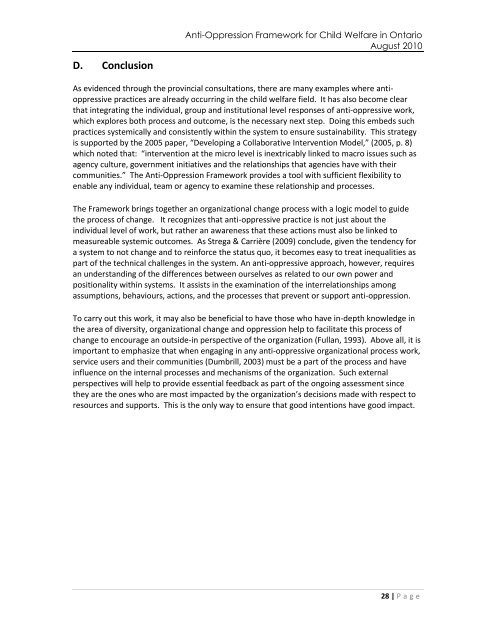An Anti-Oppression Framework for Child Welfare in Ontario
An Anti-Oppression Framework for Child Welfare in Ontario
An Anti-Oppression Framework for Child Welfare in Ontario
You also want an ePaper? Increase the reach of your titles
YUMPU automatically turns print PDFs into web optimized ePapers that Google loves.
<strong>An</strong>ti-<strong>Oppression</strong> <strong>Framework</strong> <strong>for</strong> <strong>Child</strong> <strong>Welfare</strong> <strong>in</strong> <strong>Ontario</strong>August 2010D. ConclusionAs evidenced through the prov<strong>in</strong>cial consultations, there are many examples where antioppressivepractices are already occurr<strong>in</strong>g <strong>in</strong> the child welfare field. It has also become clearthat <strong>in</strong>tegrat<strong>in</strong>g the <strong>in</strong>dividual, group and <strong>in</strong>stitutional level responses of anti-oppressive work,which explores both process and outcome, is the necessary next step. Do<strong>in</strong>g this embeds suchpractices systemically and consistently with<strong>in</strong> the system to ensure susta<strong>in</strong>ability. This strategyis supported by the 2005 paper, “Develop<strong>in</strong>g a Collaborative Intervention Model,” (2005, p. 8)which noted that: “<strong>in</strong>tervention at the micro level is <strong>in</strong>extricably l<strong>in</strong>ked to macro issues such asagency culture, government <strong>in</strong>itiatives and the relationships that agencies have with theircommunities.” The <strong>An</strong>ti-<strong>Oppression</strong> <strong>Framework</strong> provides a tool with sufficient flexibility toenable any <strong>in</strong>dividual, team or agency to exam<strong>in</strong>e these relationship and processes.The <strong>Framework</strong> br<strong>in</strong>gs together an organizational change process with a logic model to guidethe process of change. It recognizes that anti-oppressive practice is not just about the<strong>in</strong>dividual level of work, but rather an awareness that these actions must also be l<strong>in</strong>ked tomeasureable systemic outcomes. As Strega & Carrière (2009) conclude, given the tendency <strong>for</strong>a system to not change and to re<strong>in</strong><strong>for</strong>ce the status quo, it becomes easy to treat <strong>in</strong>equalities aspart of the technical challenges <strong>in</strong> the system. <strong>An</strong> anti-oppressive approach, however, requiresan understand<strong>in</strong>g of the differences between ourselves as related to our own power andpositionality with<strong>in</strong> systems. It assists <strong>in</strong> the exam<strong>in</strong>ation of the <strong>in</strong>terrelationships amongassumptions, behaviours, actions, and the processes that prevent or support anti-oppression.To carry out this work, it may also be beneficial to have those who have <strong>in</strong>-depth knowledge <strong>in</strong>the area of diversity, organizational change and oppression help to facilitate this process ofchange to encourage an outside-<strong>in</strong> perspective of the organization (Fullan, 1993). Above all, it isimportant to emphasize that when engag<strong>in</strong>g <strong>in</strong> any anti-oppressive organizational process work,service users and their communities (Dumbrill, 2003) must be a part of the process and have<strong>in</strong>fluence on the <strong>in</strong>ternal processes and mechanisms of the organization. Such externalperspectives will help to provide essential feedback as part of the ongo<strong>in</strong>g assessment s<strong>in</strong>cethey are the ones who are most impacted by the organization’s decisions made with respect toresources and supports. This is the only way to ensure that good <strong>in</strong>tentions have good impact.28 | P a g e
















